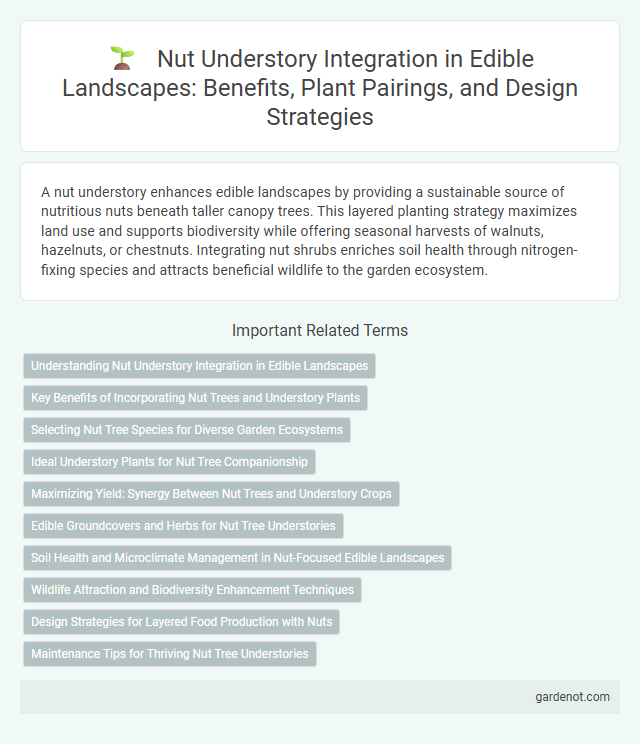A nut understory enhances edible landscapes by providing a sustainable source of nutritious nuts beneath taller canopy trees. This layered planting strategy maximizes land use and supports biodiversity while offering seasonal harvests of walnuts, hazelnuts, or chestnuts. Integrating nut shrubs enriches soil health through nitrogen-fixing species and attracts beneficial wildlife to the garden ecosystem.
Understanding Nut Understory Integration in Edible Landscapes
Nut understory integration in edible landscapes enhances biodiversity by combining productive nut-bearing shrubs and small trees beneath primary crops. This multi-layered planting approach maximizes land use efficiency and provides seasonal yields of nutritious nuts such as hazelnuts, chestnuts, and walnuts. Incorporating nut understories supports soil health through nitrogen fixation and organic matter accumulation, promoting sustainable ecosystem functions.
Key Benefits of Incorporating Nut Trees and Understory Plants
Incorporating nut trees and understory plants in edible landscapes enhances biodiversity by providing diverse habitats for pollinators and beneficial insects. Nut trees offer nutrient-rich harvests that support food security and promote soil health through nitrogen fixation and organic matter accumulation. Understory plants contribute to microclimate regulation and weed suppression, optimizing growth conditions and improving overall ecosystem resilience.
Selecting Nut Tree Species for Diverse Garden Ecosystems
Selecting nut tree species for diverse garden ecosystems requires considering climate adaptability, soil type, and growth habits to ensure healthy understory development. Species like American hazelnut, chestnut, and black walnut provide valuable edible yields while supporting biodiversity and improving soil fertility. Integrating these nut trees enhances ecosystem resilience by offering habitat and food sources for pollinators, birds, and beneficial insects.
Ideal Understory Plants for Nut Tree Companionship
Ideal understory plants for nut tree companionship include shade-tolerant species such as shade-loving herbs like wild ginger (Asarum canadense), medicinal plants like ginseng (Panax quinquefolius), and ground covers like sweet woodruff (Galium odoratum). These plants enhance soil fertility by fixing nitrogen or accumulating nutrients, support beneficial insect populations, and reduce weed competition, promoting healthier nut tree growth. Selecting native understory species also fosters biodiversity and resilience in edible landscapes centered around nut orchards.
Maximizing Yield: Synergy Between Nut Trees and Understory Crops
Maximizing yield in edible landscapes involves strategically combining nut trees with understory crops to create a mutually beneficial ecosystem. Nut trees like chestnuts or hazelnuts provide shade and nutrients, which enhance the growth of shade-tolerant crops such as leafy greens, herbs, and mushrooms beneath them. This synergy improves soil health, reduces water usage, and increases overall productivity by diversifying income sources and optimizing space.
Edible Groundcovers and Herbs for Nut Tree Understories
Edible groundcovers such as clover, creeping thyme, and strawberries can improve soil health and provide a nutrient-rich understory for nut trees by fixing nitrogen and suppressing weeds. Herbs like comfrey, chives, and mint contribute beneficial insects, enhance biodiversity, and offer culinary uses while thriving in shaded conditions beneath hazelnut, walnut, or chestnut trees. Integrating these edible plants creates a sustainable, productive ecosystem that maximizes space and supports nut tree growth.
Soil Health and Microclimate Management in Nut-Focused Edible Landscapes
Nut understory plants enhance soil health by fixing nitrogen, increasing organic matter, and promoting microbial biodiversity essential for nutrient cycling. Their dense foliage moderates microclimate conditions by reducing soil temperature fluctuations and retaining moisture, which supports resilient nut tree growth. Integrating nut understories in edible landscapes improves ecosystem function, leading to higher yield stability and sustainable soil management.
Wildlife Attraction and Biodiversity Enhancement Techniques
Nut understory plants, such as hazelnuts, walnuts, and chestnuts, serve as vital food sources for wildlife, attracting birds, squirrels, and insects that contribute to a balanced ecosystem. Techniques like intercropping diverse nut species with native shrubs and creating multi-layered vegetation structures enhance habitat complexity and support greater biodiversity. Incorporating nut understory in edible landscapes promotes ecological resilience by increasing food availability and shelter for various wildlife species throughout the year.
Design Strategies for Layered Food Production with Nuts
Incorporating a nut understory in edible landscape design enhances vertical layering, maximizing food production within limited spaces by utilizing the shaded lower canopy beneath mature nut trees. Selecting shade-tolerant, complementary species such as hazelnuts or chestnuts enables efficient nutrient cycling and soil enrichment, supporting biodiversity and long-term orchard health. Strategic spatial arrangement and companion planting optimize sunlight capture, pest management, and yield sustainability across multi-tiered food systems.
Maintenance Tips for Thriving Nut Tree Understories
Regular pruning of nut tree understories promotes airflow and sunlight penetration, reducing disease risks and encouraging healthy growth. Applying organic mulch conserves soil moisture, suppresses weeds, and enhances nutrient availability for nut trees and companion plants. Monitoring for pests and diseases early allows targeted treatments, ensuring a thriving and productive edible landscape beneath nut trees.
Nut understory Infographic

 gardenot.com
gardenot.com